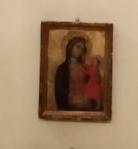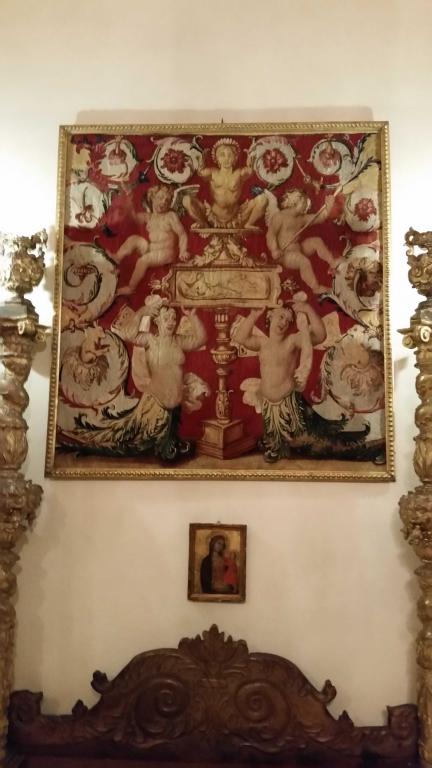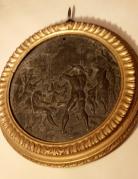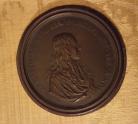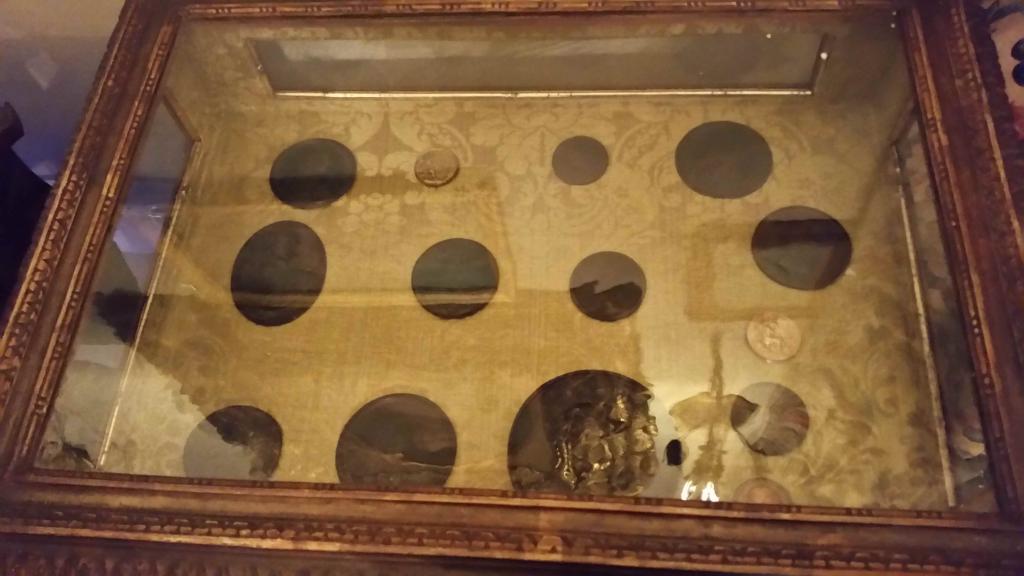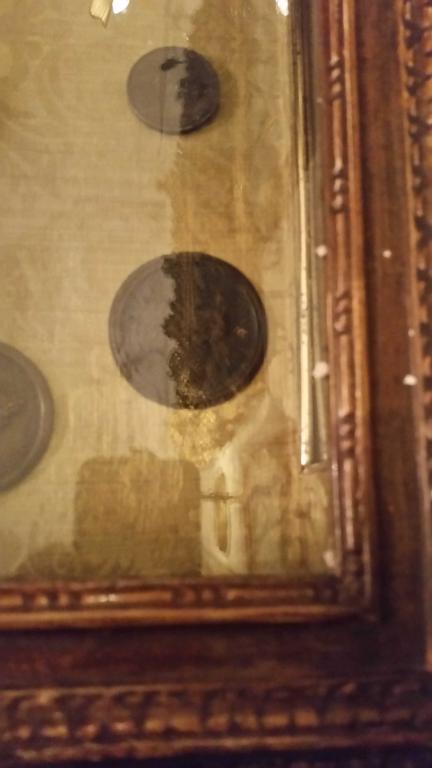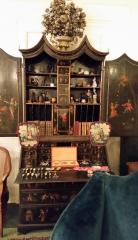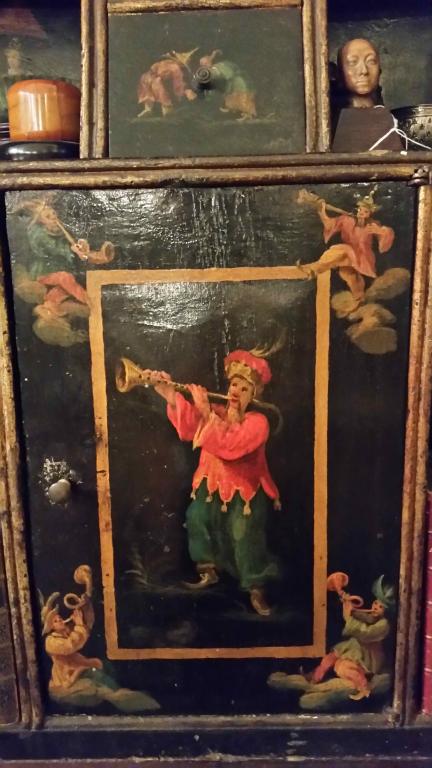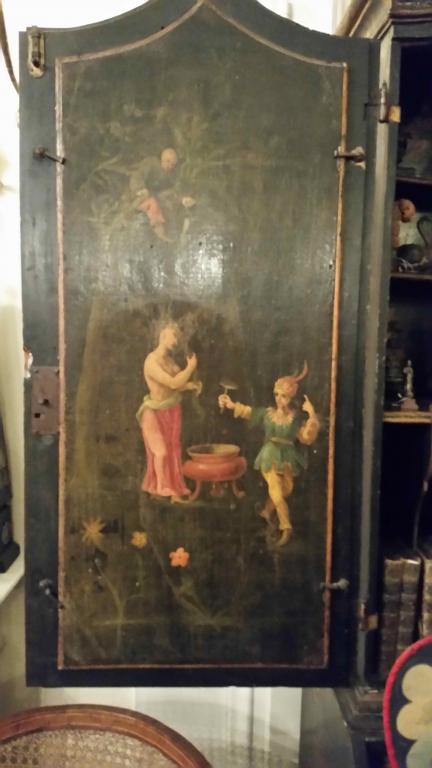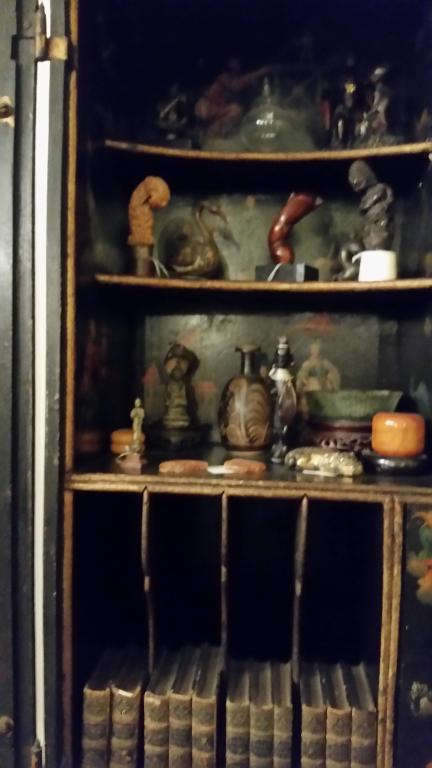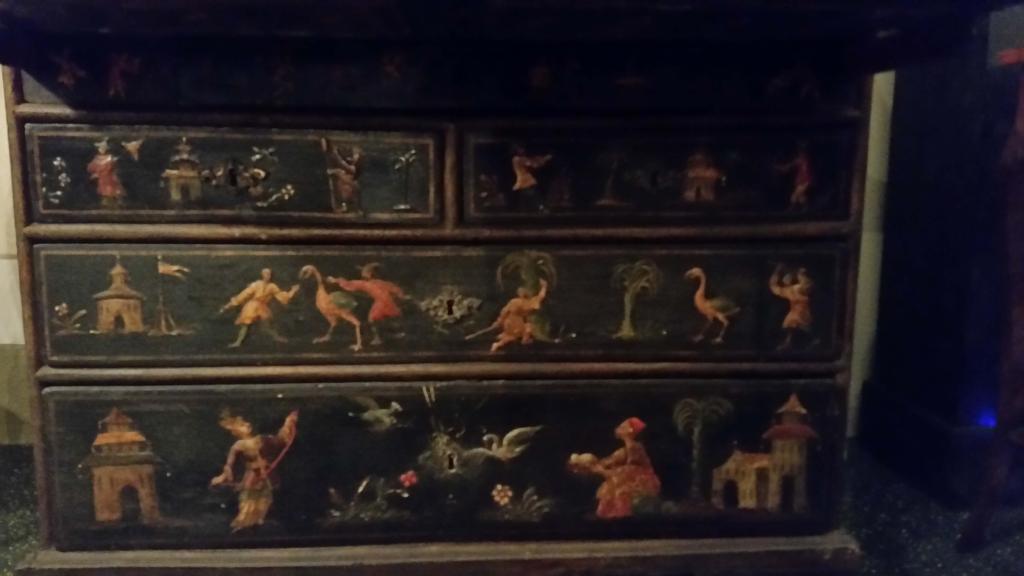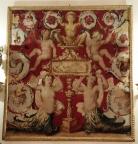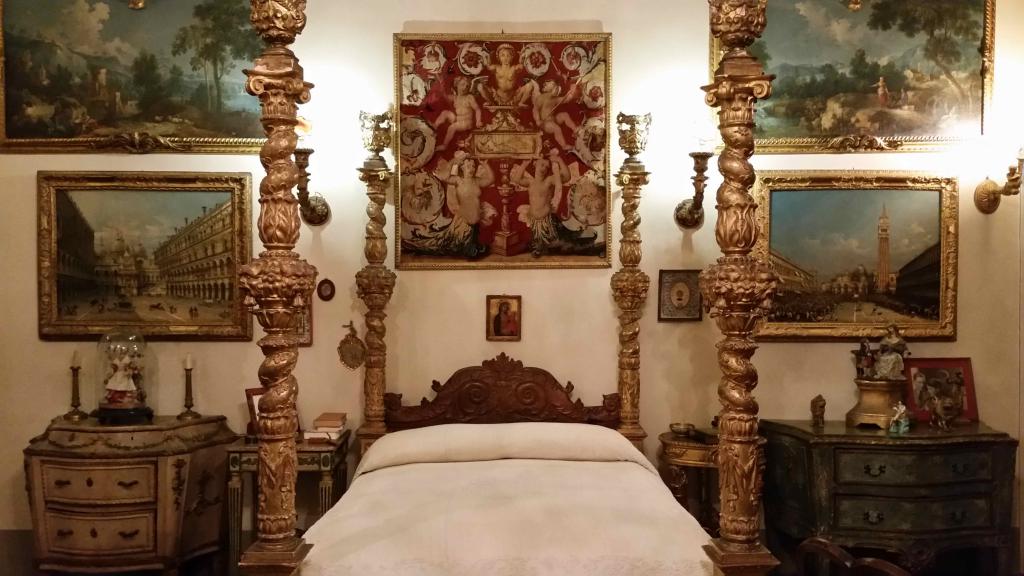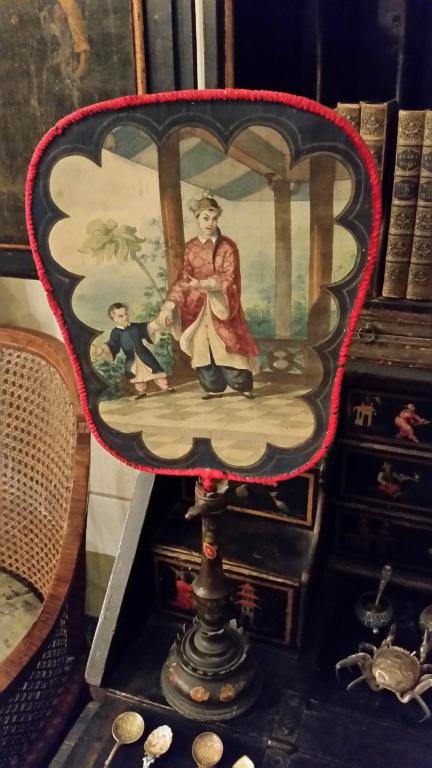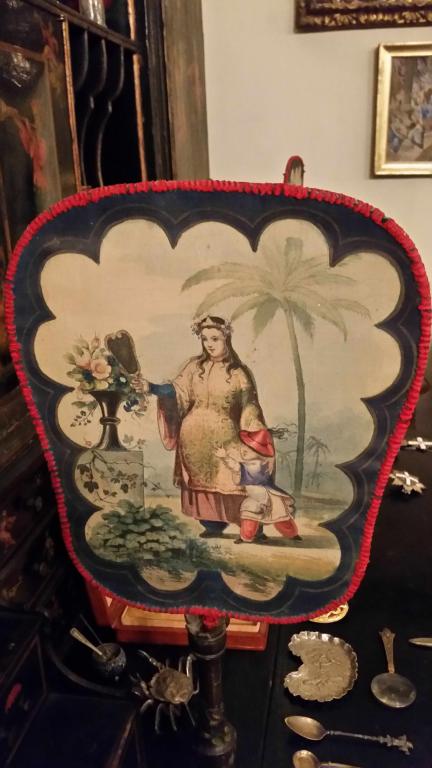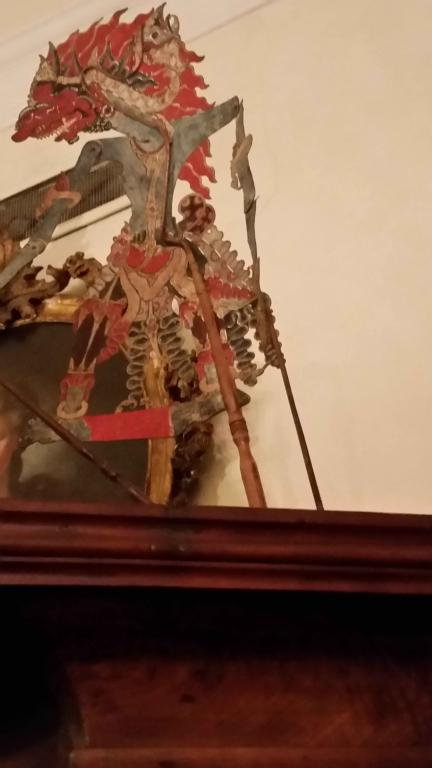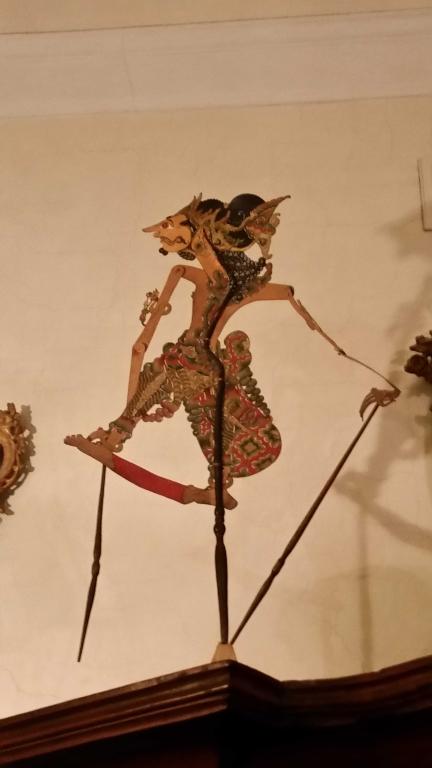Timeline - A Room, a Life, and a Legacy
Created by Jay Clayton on Thu, 05/11/2017 - 17:31
Part of Group:
This timeline features a selection of items exhibited in Harold Acton's bedroom, perhaps the most crowded aesthetic display at La Pietra. Constructed by participants in The Virtual Aesthete seminar at NAVSA (2017) held at La Pietra, the timeline and accompanying map will serve as demonstrations of ways to integrate digital technology into classroom pedagogy.
Timeline
Chronological table
| Date | Event | Created by | Associated Places | |
|---|---|---|---|---|
| circa. 1300 to circa. 1400 |
Madonna and Child, anonymous, 14th century14th century, Italian panel painting of Madonna and Child in gilt wooden frame. Anonymous artist. Tempera on panel, of the Tuscan school. Such panels tend to be within complex wooden carved frames, although in this instance the frame is quite simple.
This is the painting in situ, hanging above Harold Acton's four-poster bed in his bedroom in La Pietra, Florence. Above the painting is hung a textile depicting two putti. The pose of the Madonna and Child recalls famous examples of such iconography, such as Duccio di Buoninsegna's Stoclet Madonna (which is contemporary, or perhaps earlier than this example). It has been suggested in relation to this other example that the childish reach of the Christ child's hand is distinctive of the sensibility of the Tuscan school that imbues the figures with palpable human emotion, the Virgin’s somewhat austere gaze being indicative of her anticipating Christ’s future. Clare Stainthorp |
|||
| circa. 1575 |
Vulcan's Forge, Monogrammist A.Z., late 16th centuryLate 16th century, circular lead plaquette Monogrammist A.Z. Vulcan The Roman god of fire (including that of volcanoes, metalworking, and the forge) Vulcan's Greek counterpart is Hephaestus. The festival of Vulcan, the Vulcanalia, was celebrated on August 23 each year, when the summer heat placed crops and granaries most at risk of burning.
ROMAN BRONZE VOTIVE PLAQUE OF HEPHAISTOS (VULCAN) GOD OF THE FORGE Standing nude within an aedicula, or shrine, with arched pediment supported by columns. In his right hand he holds a hammer about to strike and anvil atop an altar; in his left a pair of tongs. |
|||
| circa. 1600 |
Italian Giltwood and Walnut Four-Poster Bedstead, 17th century17th century, Italian furniture It is often said that a collector collects in order to build a safe world, an alternative world, a kind of nest. Sir Harold Acton's bedroom, his childhood bedroom, next to his parents' room, is a place he never moved from. In a house full of collections, he felt most at home in this intimate space filled with what we can surmise are his most beloved collections. In this treasure-filled room, the bed is focal point. It is the sanctum sanctorum of the collector's private room. The official description provided by the museum tells us that this bed is a seventeenth-century Italian giltwood and walnut four-poster bedstead. Examining the bed, particularly in the context of such an eclectic collection of beloved items, calls attention to its varied styles and finishes. The carving of the bedframe, headboard, and footboard, which are ungilded walnut, are distinct from the columns that are finished in gold gilt. The bedframe and headboard appear to be carved in a different style than the columns. These columns are topped with 4 urns, which have a different metallic finish than the columns themselves. This leads us to suspect that the bed is itself a collection of objects, styles, and perhaps even periods. However, it also seems like a perfect bed for an Anglo-Italian leading the villa life on a hillside above Florence. The bed's place within the composition of the room is also interesting. Two of the massive columns frame the putti under which there is a painting of the madonna and child, a visual blending of the classical and the Catholic. It is a composed world, the symmetry of which provides a structure that unites its disparate parts. For Acton, it is both a beautiful and sacred space. (Might the bed's columns be repurposed from an architectural element in a church?) The space feels like the space of an aesthete who admires the beauty of the pagan, the power of the Catholic, and the majesty of connoisseurship. -Barbara Black (Skidmore College) and Renata Kobetts Miller (City College of New York) |
|||
| circa. 1675 |
Medal of Gian Gastone de'Medici, Massimiliano Soldani Benzi, 17th centuryLate 17th century, Italian bronze medal Massimiliano Soldani Benzi
|
|||
| circa. 1700 |
Bureau Cabinet, 18th centuryEarly 18th century, Italian furniture
|
|||
| 1705 to 1713 |
Grotesque with Two Putti, Gobelins Manufactory, 1705-171318th century, French Textile Gobelins Manufactory Noel Coypel (Cartoon design)
|
|||
| circa. 1750 |
Holy Family: Rest on the Flight into Egypt, Pietro Bardellino, 18th century18th century, Italian painting Pietro Bardellino was a time-travelling pirate from the outer Hebrides. His real name was Peter Bawdy and appeared in several of Shakespeare's plays briefly in the 18th century, before disappearing and rematerializing in an episode of Frasier. He mastered the craft of painting by doing tourist portraits in Trafalgar Square. He is famous for his use of translucent green pigment derived from orange pips harvested in Drury Lane Theatre. His paintings are renowned for their invisibility, the current example being a rare exception. The provenance of the painting can be traced back as far as 1789, when it was hung in the cell of the Marquis de Sade during his incarceration in the Bastille, before briefly passing into the hands of Robespierre. The next time it occurs in a catalogue is when it is associated with the will of Lord Byron's Albanian host, Velly Pasha of Tepelena. It came into Harold Acton's possession when he bought an antique trunk that had belonged to Cyril Graham, the subject of Oscar Wilde's 'The Portrait of Mr WH'. Antonija Primorac Merrick Burrow |
|||
| circa. 1800 |
Pair of Italian Brown and Polychrome Decorated Table Fans, 19th centuryEarly 19th century, English Chinoiserie table fans
This pair of fans sits on the front flap of a bureau in the ante-room to Acton's bedroom. The fans date from the early C19th, and are part of the Western European craze for Chinoiserie. They are made of broad-woven silk; measure roughly 10" by 6", and have removable panels. They have no functional handle, but are mounted on a balustrade-style support - rather like a candle-holder - and a domed foot decorated with flowerheads. The fans comprise four different scenes, each having a recto and a verso. The scenes are more suggestive of Chinese motifs than directly representational. On the recto of Fan #1 is a woman - possibly pregnant - holding a small child by the hand, and standing in a scene which is both Westernized in its flower urn and tropical in its palm trees. The recto of Fan #2 depicts two adult males in front of a river or water, with a pagoda and, again, palm trees in the background. One man holds a scroll and is possibly a teacher or a trader. Verso of Fan #1 shows a man holding a child by the hand on a verandah - family motifs thus dominate on this fan. The recto of Fan #2 shows two adult women - one standing, one seated - again in an outdoors scene, with rather unclear foliage. The edges of all four images are scalloped, suggesting a formal, decorative vignette. There is a red fabric edge - possibly of rough silk - around the fans' edges. The craze for Chinoiserie in Western Europe was a product of considerable trade in Chinese goods from the mid C17th to the early C19th (see Chi-Ming Yang, Performing China: Virtue, Commerce, and Orientalism in Eighteenth-century England, 1660-1760 (Johns Hopkins University Press, 2011). The fans were designed for decoration and display rather than functionality, even as they referenced East Asian habits of fanning onself (habits very necessary, of course, in places like European crowded ballrooms!). Many of the supposedly Chinese designs were created and collected by French designers. In the mid-1730s the French designer Jean Revel (1684–1751) produced a number of chinoiserie silk designs in an early Rococo style, and from the mid-1750s Jean Pillement engraved fanciful chinoiserie designs that were drawn upon by other textile designers. These were brought together in his One Hundred and Thirty Figures and Ornaments and Some Flowers in the Chinese Style (London, 1767). His designs also appeared in such source books as Recueil de différentes fleurs dans le goût chinois, propres aux manufactures d’étoffes de soie et d’indiennes (London, 1760) . They were used by textile printers in England and France, and were further drawn on as sources for other decorative objects. London's Fan Museum has held several exhibitions of Chinese fans, which focus on more functional, wide-spreading, folding fans, rather than these two objects, which seem more intended for display. |
|||
| circa. 1900 |
Pair of Thai Shadow Puppets, possibly 20th century
Summary Thai shadow puppets are used in both classical and folk theater. There are two types of shadow theater in Thailand: nang talang and nangyai. The size of puppets usually between .75 metres to 1.25 metres. They are made of buffalo or cow hide. Usually the puppets have one articulated arm; clowns typically have two moveable arms. The puppet that represents the hero tends to be small with delicate features while the villain puppet tends to be large and unattractive. Puppets who represent gods are always the smallest in size. Clown puppets are ugly and can even have movable chins and genitals, but they are also know to be insightful (much like Shakespeare's fools). The puppets are manipulated by puppeteers behind white screens so that they appear as shadows, which makes one wonder why they are so intricately and colorfully painted. A small fire or lamp is used behind the screen, and all of this is managed by single puppeteer who narrates and sings. Four or five musicians accompany the play ("Thailand IX: Theatre," Oxford Art Online, article url: http://www.oxfordartonline.com.proxy.library.vanderbilt.edu/subscriber/a...).
Example of live shadow puppet show |
|||
| 1911 |
Folding fan painted on textile with tassel, Georges Barbier, 19111911, French costume textile accessorie (fan)Georges Barbier, French, 1882-1932, illustrator, painter, water colourist, stage and costume designer. Known for Art Deco. Books Illustrated: Poetry by Charles Baudelaire; R. Boylesve's The Baths at Baden; The Carriage with Two Green Lizards; Mirages by Baroness de Brimont; A. Flament's Characters in Comedy (Personnages de Comédie); The Romance of the Mummy (Le Roman de la Momie) by T. Gautier (Mornay, pub. 1929); Guérin's Prose Poems (Poèmes en Prose); P. Loüys's Songs of Bilitis (Les Chansons de Bilitis), Dances by Nijinsky (Danses de Nijinsky) by F. de Miomandre; Alfred de Musset's You Don't Play with Love (On ne Badine pas avec l'Amour); H. de Régnier's The Double Mistress (La Double Maîtresse); Rostand's Casanova; Schwob's Imaginary Lives (Vies Imaginaires); Stelov's Anna Pavlova; the Album Dedicated to Tamara Karsavina (Album Dédié à Tamara Karsaviva) and Paul Verlaine's Fêtes Galantes. Other works he illustrated include: The Song of Songs; Makeda, Queen of Sheba; Le Bonheur du Jour ou les Graces à la Mode and Fashions and Manners of Today.
An Example of a Book Illustration by Georges BarbierBarbier is known for his Art Deco style, a style of arts in US and Europe in the 1920s-1930s, so this fan predates the widespread adoption of this style. Probably the fan responds to the popularity of the Ballet Russes. Note that Barbier illustrated several books related to Russian ballet. The fan is paint on textile, depicting a scene of music and dance on a blue background. The ribs of the fan appear to be red polka-dotted lacqueur wood. The tassle is multicoloured cream and gray (possibly faded), possibly silk. The scene on the fan blends classical antiquity with modern interior design. Turquoise and black tile floor meets blue wallpaper or starry sky, with a golden tree with three grey doves or other birds. The dancers have colorfull headpieces, scantily clad, with drapery flowing to the right of the fan, the central figure's drapery echoes the red and golden polka dot pattern of the base ribs on the handle. On the left, a kneeling, feminine satyr is blowing on pan pipes. Alison Booth & Natalie Roxburgh |

